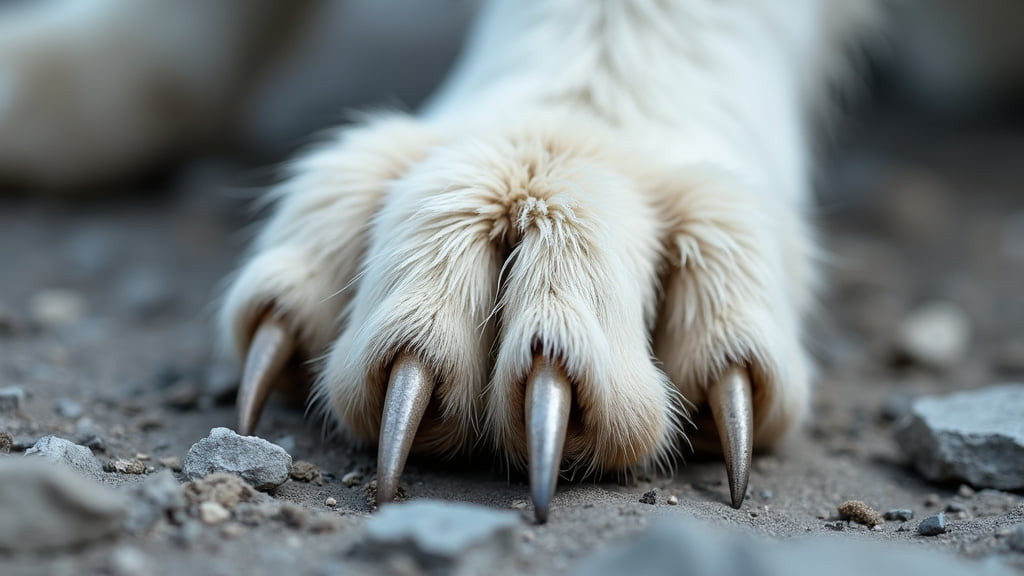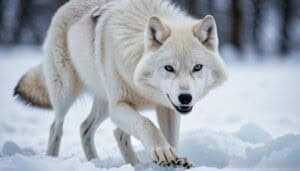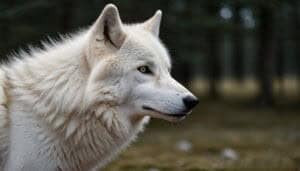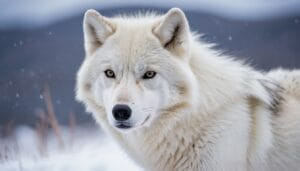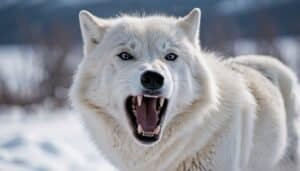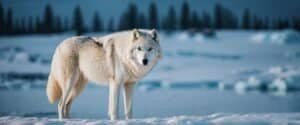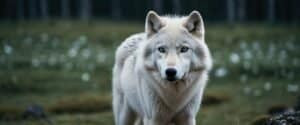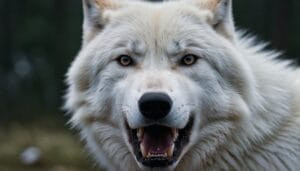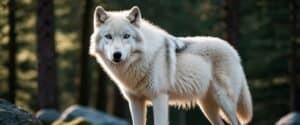Introduction
Arctic wolves, also known as white wolves, are well-adapted to the harsh conditions of their icy habitats. One of their key adaptations is their claws, which play a crucial role in their survival
In this article, we will explore the length and physical adaptations of Arctic wolf claws, how they are used in the wild, and how they compare to other canines
Additionally, we will examine the role claws play in hunting and survival, as well as their growth and maintenance throughout the wolf’s life cycle
Average Length and Physical Adaptations of Arctic Wolf Claws
The claws of an Arctic wolf are an essential adaptation for surviving in their cold and rugged environment. These claws are not only tools for hunting but also crucial for various activities that ensure the wolf’s survival
Measurement Details
Arctic wolf claws are generally about 2 to 3 inches long. The length can vary slightly based on factors like age, sex, and individual genetic differences
Their claws are curved and sharp, allowing them to grip ice and snow effectively, which is vital for their mobility in the Arctic tundra
Variation Among Individuals
While the average length of an Arctic wolf’s claws is fairly consistent, there are variations among individual wolves
These differences can be attributed to the wolf’s diet, health, and environmental conditions. For instance, wolves that frequently dig or engage in activities that wear down their claws might have slightly shorter claws than those who do not
Claw Structure
The structure of an Arctic wolf’s claws is robust and well-suited for their environment. Each claw is composed of a hard keratin sheath covering a sensitive core known as the quick
This design provides both strength and flexibility, enabling the wolf to perform various tasks such as hunting and digging. The curvature of the claws helps in anchoring themselves in the snow and ice, providing stability and balance
Seasonal Changes
Interestingly, the condition and wear of Arctic wolf claws can change with the seasons. During winter, when the ground is covered in snow and ice, the claws are less likely to wear down quickly, maintaining their length and sharpness
In contrast, during the brief Arctic summer, when the ground is more exposed, the claws might wear down more due to increased digging and movement over rougher terrain. This seasonal variation ensures that the claws remain functional throughout the year, adapting to the changing conditions of their environment
The physical adaptations of Arctic wolf claws highlight the remarkable ways these animals have evolved to thrive in one of the harshest climates on Earth. Their claws are not just simple appendages but complex tools that play a significant role in their daily survival
Uses of Arctic Wolf Claws in the Wild
Arctic wolf claws are multifunctional tools that are crucial for various aspects of their survival. These claws assist in hunting, movement, and other essential activities that enable the wolf to thrive in its harsh Arctic environment
Hunting Techniques
Arctic wolves use their claws extensively when hunting. Their sharp, curved claws are ideal for gripping and holding onto prey
When pursuing animals such as muskoxen, Arctic hares, or lemmings, the wolves rely on their claws to secure their catch. The claws help in delivering a firm hold, preventing the prey from escaping and allowing the wolf to deliver a fatal bite
In addition to capturing prey, Arctic wolves use their claws to dig out smaller animals from burrows or beneath the snow
This technique is particularly useful during the winter months when food is scarce, and the ability to extract hidden prey can mean the difference between life and death. Studies have shown that Arctic wolves can detect and dig out small mammals that are hidden beneath several inches of snow, showcasing their claws’ efficiency in securing food
Digging and Movement
Beyond hunting, Arctic wolves use their claws for digging and movement. Digging is a vital activity for various reasons, including creating dens, accessing hidden food sources, and making resting spots
The claws’ strength and shape make them perfect tools for excavating hard, frozen ground, allowing the wolves to create shelters that protect them from the extreme cold and wind
Movement across the icy and snowy terrain of the Arctic is another area where claws play a significant role. The claws provide traction, preventing the wolves from slipping on the ice and enabling them to navigate the treacherous landscape efficiently
This traction is particularly important during the hunting of larger prey, as it allows the wolves to maintain their balance and speed during the chase
Arctic wolves’ claws also aid in climbing over rough and uneven surfaces. Although these wolves do not climb trees like some other canines, they often need to navigate rocky outcrops and steep slopes. Their claws provide the necessary grip to handle these challenging terrains, ensuring they can reach various areas within their territory
The multifunctional use of Arctic wolf claws in hunting, digging, and movement underscores their importance in the wolves’ daily lives. These claws are essential tools that enhance the wolves’ ability to survive and adapt to their harsh surroundings
Comparison with Other Wolves and Canines
The claws of Arctic wolves differ significantly from those of other wolves and domestic dogs. These differences highlight the unique adaptations that Arctic wolves have developed to survive in their frigid environment
Differences with Other Wolves
Arctic wolves (Canis lupus arctos) have evolved distinct claw characteristics compared to other wolf subspecies, such as the gray wolf (Canis lupus lupus) or the red wolf (Canis rufus). While all wolves have claws designed for hunting and movement, the specific environmental challenges faced by Arctic wolves have led to certain adaptations
One major difference is the length and sharpness of the claws. Arctic wolves tend to have slightly longer and sharper claws compared to their southern counterparts
This adaptation aids in navigating the icy terrain and capturing prey that is often more difficult to hunt due to the harsh conditions. The claws of Arctic wolves are also more curved, providing better grip on slippery surfaces, which is essential for maintaining balance on ice and snow
The wear and tear of claws also vary among wolf subspecies. For example, gray wolves, which often inhabit forested and rocky regions, may have more worn claws due to frequent digging in harder ground. In contrast, Arctic wolves, living in areas where the ground is often covered with snow, tend to have less wear on their claws
Comparison with Domestic Dogs
Comparing Arctic wolf claws to those of domestic dogs (Canis lupus familiaris) reveals even more pronounced differences. Domestic dogs, bred for various purposes and living in more controlled environments, have claws that are generally less specialized for survival in extreme conditions
The claws of domestic dogs are usually shorter and less curved compared to those of Arctic wolves. This is because domestic dogs do not need to navigate icy terrains or hunt for survival. Instead, their claws are adapted to activities such as running on flat surfaces or digging in softer soils, depending on their breed and lifestyle
For instance, breeds like the Siberian Husky or Alaskan Malamute, which are used in colder climates and for activities such as sledding, have claws that are more similar to those of Arctic wolves, although still not as specialized. These dogs have stronger and slightly more curved claws compared to other domestic breeds, aiding them in gaining traction on snow and ice
In contrast, smaller breeds like Chihuahuas or breeds designed for specific purposes like the Dachshund (bred for digging into burrows) exhibit claws that are quite different from those of Arctic wolves. Their claws are adapted to their specific environments and needs, showcasing the wide range of claw adaptations within the canine family
Overall, the comparison of Arctic wolf claws with those of other wolves and domestic dogs highlights the unique evolutionary adaptations that have equipped Arctic wolves to thrive in their specific habitats. These differences underscore the importance of claws as crucial tools for survival, tailored to the environmental demands faced by each species or subspecies
Role of Claws in Arctic Wolf Hunting and Survival
The claws of Arctic wolves are integral to their hunting strategies and overall survival in the harsh Arctic environment. These versatile tools enable the wolves to secure prey, defend themselves, and navigate the challenging landscape
Catching Prey
Arctic wolves rely heavily on their claws to catch and hold onto prey. Their hunting methods often involve chasing down animals such as caribou, muskoxen, and Arctic hares
The sharp, curved claws allow them to grip their prey firmly, preventing escape during the critical moments of a hunt. For larger prey, such as muskoxen, the wolves use their claws to latch onto the animal, pulling it down to deliver a fatal bite
During the chase, the claws provide the necessary traction on slippery and uneven terrain, enabling the wolves to maintain speed and agility
The ability to dig their claws into the ground while running helps prevent slipping, which is crucial when pursuing fast-moving prey across ice and snow. This adaptation is particularly important in the Arctic, where the landscape can be treacherous and the conditions severe
Arctic wolves also use their claws to dig out smaller prey from beneath the snow. This technique, known as “snow plowing,” involves the wolf using its claws and paws to move snow aside and access hidden animals such as lemmings and Arctic ground squirrels
This behavior is vital during the winter months when other food sources are scarce, and the ability to uncover hidden prey can be a matter of survival
Defensive Mechanisms
In addition to hunting, Arctic wolf claws play a critical role in defense
When faced with threats from other predators, such as polar bears or rival wolf packs, Arctic wolves use their claws to defend themselves and their territory. The sharp claws can inflict serious wounds on attackers, serving as a deterrent and providing the wolves with a means to protect themselves and their pack
The claws also aid in establishing dominance within the pack. During confrontations or disputes over hierarchy, wolves use their claws in combination with their teeth to assert dominance and maintain social order. This behavior helps to prevent serious injuries and ensures the stability of the pack structure, which is essential for cooperative hunting and overall survival
How Claws Aid in Survival
Beyond hunting and defense, the claws of Arctic wolves are crucial for various survival tasks
One important use is in creating and maintaining dens. Arctic wolves dig extensive dens using their claws, which provide shelter from the extreme cold and protection for their pups. These dens are typically dug into snowbanks or soft soil and can be used for many years, with the wolves regularly maintaining and expanding them as needed
The claws also assist in grooming and maintaining the wolves’ overall health. Wolves use their claws to scratch and remove parasites, such as ticks and fleas, which can be detrimental to their health if left unchecked. This grooming behavior is essential for preventing infections and ensuring the wolves remain in peak condition to hunt and defend themselves
Furthermore, the claws play a role in territorial marking. Wolves use their claws to scratch trees, ground, and other surfaces within their territory, leaving visual and scent marks that signal their presence to other animals. This marking behavior helps to establish and maintain the boundaries of their territory, reducing conflicts with other predators and rival wolf packs
The multifaceted use of claws in hunting, defense, and daily survival tasks underscores their importance to Arctic wolves. These adaptations highlight the wolves’ remarkable ability to thrive in one of the most challenging environments on Earth
Maintenance and Growth of Arctic Wolf Claws
Arctic wolf claws require regular maintenance and undergo growth cycles that ensure they remain functional and effective throughout the wolf’s life. Understanding the growth and maintenance of these claws provides insight into how Arctic wolves stay prepared for the demands of their environment
Natural Wear and Tear
The claws of Arctic wolves experience natural wear and tear due to their constant use in hunting, digging, and movement across rugged terrain
Unlike domestic dogs, which may require nail trimming, wild wolves maintain their claws through daily activities. The rough surfaces they traverse help to naturally file down their claws, preventing them from becoming too long and unmanageable
The icy and snowy conditions of the Arctic also influence the wear of wolf claws. During winter, the softer ground covered in snow reduces the rate of wear, allowing the claws to maintain their sharpness and length
Conversely, during the summer months, when the ground is exposed and harder, the claws may wear down more quickly. This seasonal variation ensures that the claws are always in a suitable condition for the changing environment
Development from Pups to Adults
Arctic wolf pups are born with soft, undeveloped claws. As they grow and begin to explore their surroundings, their claws gradually harden and lengthen, adapting to their needs. During the early stages of life, pups rely on their claws to climb over their denmates and navigate their immediate environment
By the time they reach adulthood, usually around one to two years of age, Arctic wolves have fully developed claws that are strong and capable. The growth of their claws is influenced by factors such as diet, activity level, and overall health. A nutrient-rich diet ensures that the claws grow properly and remain robust
The process of claw growth involves the continuous production of keratin, the protein that forms the hard outer sheath of the claws
As new keratin cells are produced, the older cells are pushed outward, causing the claws to grow in length. This cycle of growth and natural wear maintains the claws at an optimal length for their various functions
Claw Health and Maintenance
Maintaining healthy claws is crucial for Arctic wolves, as damaged or infected claws can impede their ability to hunt and move effectively
Wolves engage in grooming behaviors that help to keep their claws in good condition. They often lick their paws and claws to clean them, removing dirt and parasites that could cause infections
Injuries to the claws, such as cracks or breaks, can occur during hunts or territorial disputes. When this happens, wolves may adjust their activities to allow the claw to heal. The natural regenerative properties of keratin help in repairing minor damages, ensuring the claws remain functional
Research into the claw health of Arctic wolves has shown that they are generally resilient and capable of withstanding the demands of their environment. Studies indicate that wolves with well-maintained claws have higher success rates in hunting and are better equipped to defend themselves and their territory
The growth and maintenance of Arctic wolf claws are essential for their survival, highlighting the importance of these structures in their daily lives. The continuous cycle of natural wear, growth, and grooming ensures that Arctic wolves remain equipped to handle the challenges of their environment
Conclusion
The claws of the Arctic wolf are an extraordinary adaptation that plays a vital role in their survival in one of the most extreme environments on Earth
These claws, typically measuring between 2 to 3 inches, are not only essential for hunting but also for movement, defense, and various daily tasks that ensure the wolf’s well-being. Their unique physical characteristics, such as their length, sharpness, and curvature, enable Arctic wolves to navigate icy terrains, catch and hold prey, and defend themselves from predators and rivals
The differences between Arctic wolf claws and those of other wolves and domestic dogs underscore the specialized adaptations that Arctic wolves have developed
Compared to other wolves, Arctic wolves have slightly longer and more curved claws, providing better grip and stability on snow and ice. In contrast, domestic dogs have claws suited to their specific environments and needs, highlighting the diversity of claw adaptations within the canine family
The multifunctional use of claws in the wild, from hunting techniques like gripping and digging to defensive mechanisms and grooming behaviors, showcases their importance in the wolves’ daily lives
The natural wear and tear, coupled with seasonal variations, ensure that the claws remain in optimal condition for the Arctic environment. Moreover, the growth and maintenance of claws, from puphood to adulthood, emphasize the resilience and adaptability of these remarkable animals
Arctic wolf claws are a testament to the incredible evolutionary adaptations that allow these wolves to thrive in one of the harshest climates on the planet. Their claws are not just simple appendages but sophisticated tools that play a critical role in the survival and success of the Arctic wolf
